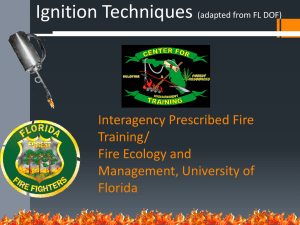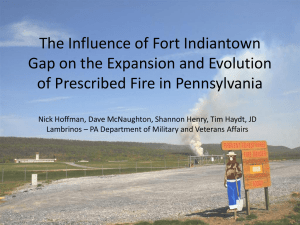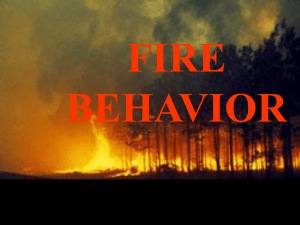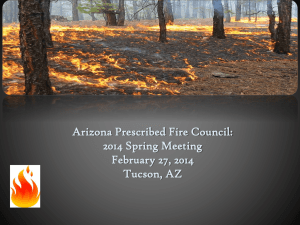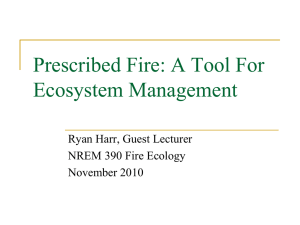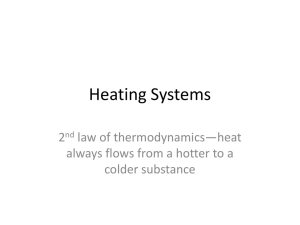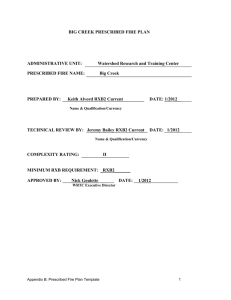Prescribed fire
advertisement
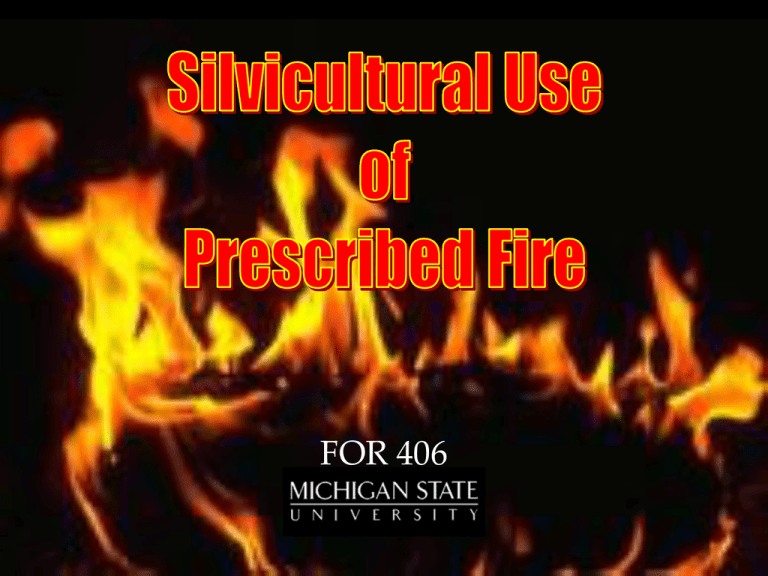
FOR 406 Harvest Regenerate Tend Prescribed burning is... • Applied in a skillful manner • At a definite location & time • Under pre-defined weather conditions • To achieve specific management objectives Anything else is a Pines Western larch Douglas-fir Giant sequoia Oaks Eucalyptus “Fire and life, in brief, form a necessary kind of symbiosis.” Stephen Pyne Sparkey WILD Remember, only you can ignite a prescribed fire! Healthy Forests Restoration Act 2003 A fire is not a fire… Surface Fire Ground Fire Crown Fire Frontal Fire Intensity I (kW m-1) = 2.598 L2.174 I (kW m-1) = 300 L2 WIND ~1.0 m I = 300 kW m-1 ~0.5 m Intensity Low I = 58 kW m-1 ~0.5 m I = 75 kW m-1 Low Intensity ~91 m I = 2,484,300 kW m-1 High Intensity <1.0 m (3 feet) Why use prescribed fire? • Reduces hazardous fuels Why use prescribed fire? • Controls woody understory Why use prescribed fire? • Controls woody understory Why use prescribed fire? • Stimulates natural regeneration & increases diversity of ground flora Why use prescribed fire? • Improves wildlife habitat & livestock forage Why use prescribed fire? • Controls certain insects & diseases Why use prescribed fire? • Recycles nutrient cations (Ca, Mg, P, K) & stimulates N fixation Why use prescribed fire? • Restores a natural (pre-European settlement) ecological process Why use prescribed fire? • Enhances aesthetics & improves access Why use prescribed fire? • Watch it burn! Weather • Fuel moisture • Fire behavior Weather Good forecasts are essential! Weather for prescribed fire • Wind – – – – Speed & direction steady 5 mph or less in the stand Direction more important than speed Interacts with topography Weather for prescribed fire • Wind – – – – Speed & direction steady 5 mph or less in the stand Direction more important than speed Interacts with topography Weather for prescribed fire • Relative humidity – 25 to 40% RH M N M Weather for prescribed fire • Temperature – <90o F (35o C) – Lethal temperature for plant tissue ~145o F – High temperature dry fuels quickly Weather for prescribed fire • Rainfall Weather for prescribed fire • Airmass stability – Resistance of atmosphere to vertical movement Weather for prescribed fire • Airmass stability—unstable – low resistance to vertical movement (large decrease in temperature with altitude) Weather for prescribed fire • Airmass stability—stable – high resistance of to vertical movement (small decrease in temperature with altitude) Mixing height 2000-6500 ft agl Transport windspeed 10-20 mph Weather for prescribed fire • Frontal activity - No approaching fronts, esp. cold fronts L Goal: accurately predict fire intensity & behavior Fine-fuel moisture & loading • Influenced by all the elements of weather • Fuel time lags Fuel moisture lags (Time it takes for a fuel to lose 63% of its moisture) Time lag 1-hour (fine fuels) Fuel diameter <¼ inch (twigs, dead grass, leaves, needles) 10-hour ¼-1 inch (twigs, small branches, cones) 100-hour 1-3 inch (branches, tops) 1000-hour >3 inch (large branches, tops, logs) Fine-fuel moisture & loading • • • • Influenced by all the elements of weather Fuel time lags 8-10% low risk conditions 10-15% high risk conditions Fine-fuel moisture & loading • • • • • Influenced by all the elements of weather Fuel time lags 8-10% low risk conditions 10-15% high risk conditions Measurement – Oven drying – Fuel sticks – Bending needles Fire Danger Rating Systems • National Fire Danger Rating System (NFDRS) • Canadian Forest Fire Weather Index System (FWI) Canadian Forest Fire Weather Index System The higher the values, the more intense the fire! Fuel Moisture Codes Fire Behavior Indices Canadian Forest Fire Weather Index System • Calculation of FWI parameters begins 3 days after either: – Final snow melt – Noon temperatures reach 54o F (12o C) • Calculation of today’s values starts with yesterday’s, then factors in 24-hour (noonnoon) weather Canadian Forest Fire Weather Index System Fire Weather Observations Fuel Moisture Codes Fire Behavior Indices Temperature Wind Relative humidity speed Wind speed Rain Temperature Relative humidity Rain Temperature Rain Target Values for Underburning Fuel moisture codes: FFMC 90-95 DMC 15-30 DC 70-100 Fire behavior indices: ISI 6-10 BUI <50 FWI 10-15 Target Values for Underburning Fuel moisture codes: FFMC 90-95 DMC 15-30 low intensity fire DC 70-100 Fire behavior indices: ISI 6-10 BUI <50 manageable behavior FWI 10-15 FFMC 90-95 DMC 15-30 DC 70-100 ISI 6-10 BUI <50 FWI 10-15 10 May 1991 Type of fire: low-intensity surface Fuel type: C5 red & white pine Fireline weather observations: temperature 80-84oF relative humidity 32-34% wind speed <2; gusts to 5 mph days since rain 5 Fuel moisture codes: FFMC 90.5 DMC 23 DC 76 Fire behavior indices: ISI 6.5 BUI 26 FWI 11.6 You’ve got to have a PLAN and you’ve got to be ready to GO… NOW! The Plan • • • • • • Burn prescription written Pre-burn site treatments completed Equipment designated & ready Personnel identified & trained Approvals & permits in hand Authorities & interested parties identified & notified* • Latest forecasts checked* * Day before & day of burn Continued FOR 406 The Plan • • • • • • Burn prescription written Pre-burn site treatments completed Equipment designated & ready Personnel identified & trained Approvals & permits in hand Authorities & interested parties identified & notified* • Latest forecasts checked* * Day before & day of burn FFMC 90-95 DMC 15-30 DC 70-100 ISI 6-10 BUI <50 FWI 10-15 2-3 weeks Ignition Devices Ignition Devices • Hand-held/ground-based – Drip torch – Propane torch – Fire fuse (flare) – Flame thrower Drip torch fuel: 3:1 or 3:2 Diesel/gasoline Ignition Devices • Aerial – Helitorch – Delayed aerial ignition device (“ping-pong balls”) Helitorch DAID Ignition Devices • Lightning Ignite a test fire first! Ignition Techniques • Backfire (backing fire) – – – – – Least intense & most predictable Short flame lengths Narrow burning zone Slow rate of spread; burns deep Low smoke output Ignition Techniques • Backfire Ignition Techniques • Headfire (heading fire) – – – – – Most intense & unpredictable Long flame lengths Wide burning zone Fast rate of spread; burns shallow High smoke output Ignition Techniques Distance between strips controls intensity WIND • Strip headfire Ignition Techniques • Spotfire – Intensity intermediate between back & head fires – Useful in shifting winds – Spots merge to form a strip head fire – What you get using a DAID Ignition Techniques • Spotfire WIND Distance between spots controls intensity Ignition Techniques • Flankfire (flanking fire) – Intensity intermediate between back & head fires – Fire spreads at right angle to wind – Limited to steady wind conditions – Requires careful crew coordination – Used primarily for securing flanks of back or head fires Ignition Techniques WIND • Flankfire Smoke Management Principles of smoke management • Have clear, defensible objectives • Comply with local pollution regulations • Notify local fire & law enforcement officials, nearby residents, & adjacent landowners • Obtain the best available weather forecasts • Don’t burn under highly stable conditions • Burn during midday; avoid night burns • Use caution near, upwind, or up-drainage of smoke sensitive areas Principles of smoke management (continued) • Use test fire to estimate smoke output & behavior • Use backing fires if feasible • Burn in small blocks if dispersion marginal • Do not burn when fuel moisture high • Don’t burn organic soils • Mop-up along roads first • Have an emergency plan! Karner blue butterfly ENDANGERED Gopher tortoise THREATENED Kirtlands warbler ENDANGERED Economics Economics Miller Lumber Co. Those who regularly work with fire develop a profound respect for its tendency to surprise the unwary. G.S. Beebe & P.N. Omi Mack Lake Fire Huron National Forest 24,000+ acres (20,000 in first 6 hours) May 5, 1980 One firefighter killed 44 homes & structures destroyed Cerro Grande Fire Los Alamos, NM May 4-11, 2000 45,000+ acres 235 homes destroyed Los Alamos National Laboratory threatened A CAREFUL MATCH … RESTORES! Sparkey Partners in promoting responsible prescribed fire

